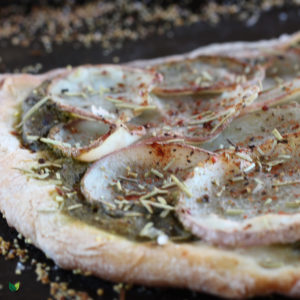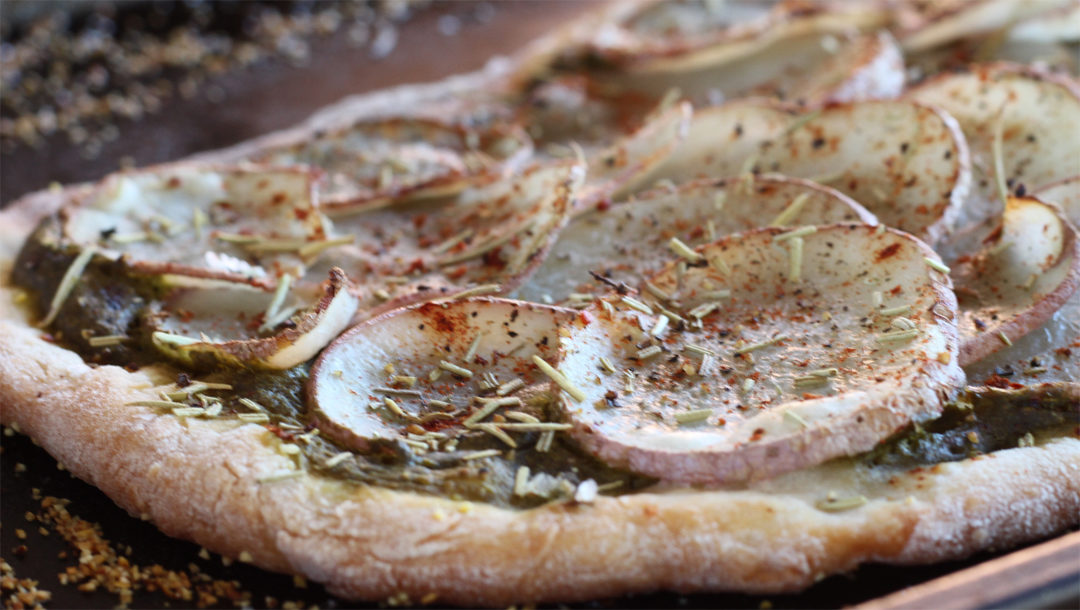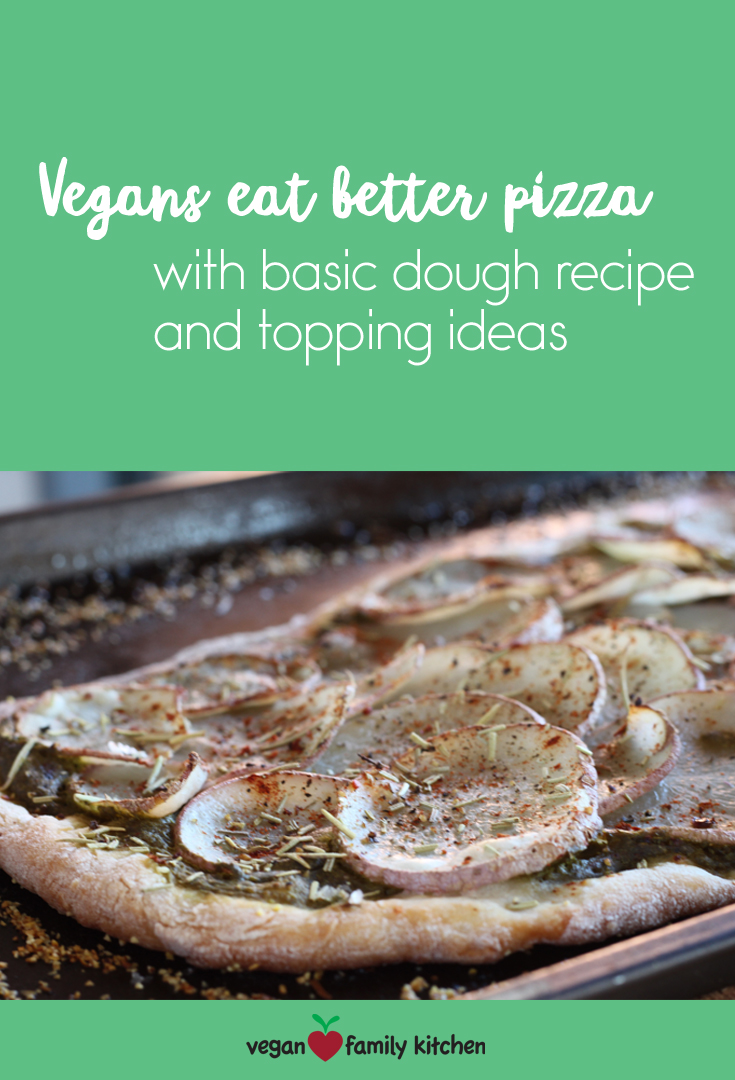I have never made so much pizza at home as since going vegan.
The first reason is that I really LOVE pizza, and so does everyone in my family. Is it pizza that I love, or a slice of warm, golden bread with some luscious toppings?
After a couple of years of trials and errors, I have finally found my favorite vegan pizza combo and the right way to order it (so that, yes, there is really no cheese on it) at the family-run firewood pizza place across the street from my home. “I’ll have a classic veggie with absolutely no cheese but extra grilled eggplant, please.” (Yes, I like to eat a medium pizza all by myself. Did you know I was a runner?) Plus, my area’s big chain pizzeria offers a decent vegan pie that features Daiya cheese and an appropriately salty meat-free pepperoni, for those occasions when I am with a group and pizza gets ordered.
But the problem with getting pizza delivered is that the non-vegans in the group will by default eat non-vegan pizza. If I make vegan pizza, they praise the crust and toppings, and devour every slice. But if I am not making it… they won’t go through the trouble of requesting the vegan options. Or they just can’t resist getting the regular cheesy pie. Either way, that makes me sad, so I just prefer making my own pizza at home instead. That way, everyone is happy.
I have occasionally bought dough ready-made from the store, but the store I patronize the most these days sells only gluten free crust… and I admit to enjoying gluten in pizza. So I make my own all the time. Believe me, it doesn’t take much time. Maybe 10 minutes more, compared to buying it? Plus a few hours of waiting. If you need pizza dough right now, then, yes, rush to the store. If it is morning and you want pizza dough for tonight, or it’s 8 pm and you’d like some pizza tomorrow, you can totally wing this.
What store-bought dough really does is remove the fear and uncertainty that comes with making pizza at home for the first few times. “Is my dough ok?” “Should it really look this lumpy?” “I think I stretched it too thin… will it burn?” When I wrote the basic recipe for pizza below, I found myself sprinkling a lot of reassurance throughout the instructions. It makes for a bit of a long story. Here is my promise to you: commit to making pizza at home at least twice in the next four weeks. And then again at least once in the following month. Then you won’t feel that you need to return to these instructions anymore.

It looks weird and scary, and then it’s delicious. Be patient!
Topping ideas
I included below my recipe for Pesto potato pizza. It’s super quick to make, and uses that jar of pesto that you inevitably have in your freezer if you have followed my anti-recipe for all those lovely greens before.
Pizza is a great way to use leftovers. Whether it’s vegan sausage (dice it!), roasted vegetables (just spread on top of a thin layer of marinara sauce), or even curry (spread on the dough and add a few dollops of chutney, followed with chopped cilantro after you take the pie out of the oven).
My kids love good old pepperoni pizza that I make using Yves’ meatless pepperoni and Daiya mozza-style shreds. With a jar of pizza sauce from the store, it comes together in no time. (The grown-up version of that is a jar of antipasto and some cashew cream… but I will shamelessly steal a square of their pizza, given the chance.)

Pesto, antipasto from a jar, and cashew cream.
What are your favorite pizza topping?

Basic pizza
Ingredients
- 1 teaspoon olive oil (or non-stick spray) for the bowl
- 3 cups all-purpose flour you can sub up to 1/2 cup whole wheat flour
- 2 teaspoons active dry yeast
- 1 1/4 cups water cold is ok if fermenting over at least 8 hours, otherwise use warm water - see tips above
- 1 1/2 teaspoons sea salt
Instructions
- At least 6 hours (and up to 24 hours) ahead, oil a large mixing bowl lightly (or use non-stick spray). Mix the flour, active dry yeast and salt at the bottom of the bowl. Slowly add the water and stir until all the flour is wet. It will look like an unappealing blob, that's okay.
- Soak a clean tea towel under running water. Wring really well so there are no more drips. Use the wrung towel to cover the bowl containing the dough.
- Leave the dough to rise on the kitchen counter for at least 6 hours. Up to 24 is great. If it's really cold in your kitchen, you can put the dough in the oven with the light on (but make sure not to turn on the element!!)
- When you are ready to make the pizza, preheat the oven to 450 degrees F. Prepare your baking sheets by gently oiling and dusting with corn meal, unless you completely trust the non-stickiness of your pizza ware.
- Dust your clean kitchen counter with a generous amount of flour. Dump the dough and kneed it for about 2 minutes, just enough to integrate all the weird-looking bits into a smooth-looking dough. It doesn't need to be perfect.
- Break the dough into two balls. I find each ball to cover a 11X17-inch baking sheet well. You can make more smaller pizzas if desired.
- Stretch the dough with your hands and use a rolling pin if desired. Transfer to the baking sheet and adjust with your fingers. It doesn't need to be perfect!
- Add your favorite toppings on the stretched pizza dough. Start with something saucy like tomato sauce or pesto, or even a thick, cheesy white sauce. Finish with a dusting of sea salt flakes and fresh ground pepper.
- Bake in the oven for 15-20 minutes, or until the crust and toppings has lots of golden bits. If using two racks, consider swapping the pizzas partway through cooking.
- Let the pizza rest for 5 minutes before slicing. Enjoy!
Notes

Pesto potato pizza
Ingredients
- 1 ball pizza dough
- 1 large potato brushed well
- 3 teaspoons salt for the brine
- 4 cups water for the brine
- 1 1/2 cups pesto homemade or from the store - check that it's dairy-free
- 1 teaspoon rosemary
- 1/2 teaspoon smoked paprika optional
- 1/4 teaspoon chili flakes or Aleppo pepper
- 1/2 teaspoon salt to sprinkle on top
- fresh ground pepper
Instructions
- Make sure you have pizza dough on the go (or a thawed ball of dough at hand).
- About an hour before eating, prepare the potato topping. Mix 3 teaspoons of salt into about 4 cups of water and stir well to dissolve. Using your sharpest knife, or a mandolin, slice the potato very thinly. Place the slices in the salty water to soften for at least 30 minutes. Up to 3 hours is fine.
- Warm the oven to 450 degrees Fahrenheit. Prepare your baking sheets by gently oiling and dusting with corn meal, unless you completely trust the non-stickiness of your pizza ware. Prepare your pizza dough per the basic pizza recipe instructions, steps 4 to 7, or follow package instructions if store-bought.
- Pour the pesto on the stretched dough and spread it all over, using the back of a spoon, a silicone brush, or your fingers.
- Layer the potato slices all over the pizza. Some overlapping is great.
- Hold the rosemary in the palm of one hand and crush it with your fingers as you sprinkle it all over the potato slices. Sprinkle some smoked paprika, chili flakes (if desired), salt and fresh ground pepper on top.
- Bake in the oven for 15-20 minutes, or until the crust and potatoes are golden.
- Allow to rest for 5 minutes before slicing. Enjoy!




